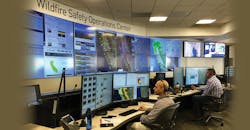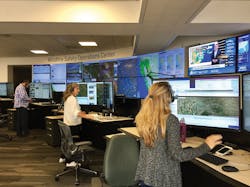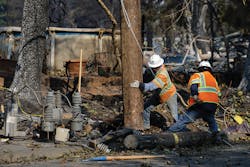From a high-floor office perch in the utility’s downtown San Francisco, California, U.S., headquarters, Pacific Gas & Electric Co. is keeping watch over some 70,000 sq miles (181,299 sq m) of its California service territory, watching and warning when conditions look ripe for another wildfire. The utility’s Wildfire Safety Operations Center (WSOC) opened in May 2018, serving as a 24/7 hub for monitoring wildfire risks and coordinating prevention and response efforts across Northern and Central California. The center has round-the-clock access to some 440 weather stations with high-definition cameras in high fire-threat areas and sees continuous live feeds from line personnel throughout the state as they go about their daily line work.
WSOC looks a bit like any utility’s distribution operations center, except — instead of displaying live maps of circuits and distribution lines — the walls are filled with a variety of data points on maps of the Pacific Gas & Electric (PG&E) service territory. For instance, one shows the locations of crews involved in high-risk work. Another one features all the weather stations and cameras at the utility’s disposal. A third shows wind speed and direction throughout the territory, with wispy lines of motion that change color as wind speeds accelerate. One map shows system-wide outages, whether related to fire or not, so the utility can cross-reference with fire location maps to see if a fire of any kind is associated with an outage.
Responsibilities of the WSOC and its workers are to detect and monitor wildfire incidents and progression, communicate wildfire-related information to the public, do real-time fire spread modeling and dispatch safety infrastructure protection teams (SIPTs) in the event of a wildfire incident. At the heart of the center is software that looks at PG&E’s cameras and weather station information, monitors outages through the service territory, examines both electrical and T&D as well as information technology (IT) assets, and reports on real-time incidents. In 2019, PG&E added an advanced weather webpage — available to the public — that offers a seven-day look-ahead regional forecast, updated daily by PG&E meteorologists and fire scientists.
A Weather Webpage
The weather page encompasses nine geographic regions of PG&E’s service territory, looking for conditions conducive to wildfire formation, and offers one of four levels of readiness for PG&E to issue a public safety power shutoff (PSPS), wherein the system proactively turns off electric power lines in the interest of public safety. Gusty winds and dry conditions naturally are the primary drivers behind a call for a PSPS.
The four levels of likelihood to call a PSPS are as follows:
- Not expected
- Elevated
- PSPS Watch
- PSPS Warning.
In some ways, these levels are analogous to hurricane forecasting as well as severe thunderstorm and winter storm warnings. A PSPS Watch generally is issued at least 72 hours prior to the anticipated or forecast declaration of a PSPS, while a PSPS Warning means homes and businesses in the affected areas actively are being warned their power may soon be shut off.
PSPS Warnings generally are based on, but not limited to, the following factors:
- A red-flag warning declared by the U.S. National Weather Service
- Fire potential outlooks from the Interagency Geographic Area Coordination Centers (GACCs)
- Low humidity levels, generally 20% and below
- Forecasted sustained winds above 25 mph (40 kmph) and/or wind gusts in excess of approximately 45 mph (72 kmph), factoring in site-specific elements such as temperature, terrain and local climate
- The condition of live fuel on the ground as well as the moisture content of live vegetation
- On-the-ground real-time observations from PG&E line workers and WSOC staff that have been dispatched to the area.
To PSPS or Not to PSPS
While customers in high-threat areas are more likely to be affected, the utility said any of its more than 5 million customers could have their power shut off as a result of a PSPS. This is because feeder lines outside the affected area may need to be curtailed to turn off power to the area most in danger.
According to the utility, outages resulting from a PSPS could be over within a few hours, in one day or last up to several days, depending on weather conditions. These are the tips the utility gives for preparing for a PSPS:
- Confirm or update contact information with PG&E to be aware when an outage is planned and when power likely will be restored.
- Create a safety plan for all members of the family, including pets.
- Prepare an emergency supply kit, including water and nonperishable food, for up to one week.
- Determine if a landline telephone will work during an outage. Keep a mobile phone as backup.
- Keep mobile phones and other devices charged
- If you have a generator, make sure it is ready to be run
- Have flashlights available for the household and avoid using candles.
- Have a battery-powered or crank radio.
- Stock up on the right batteries for critical items.
- Keep cash on hand and a full tank of gas. ATMs and gas stations may not be available during an outage.
- Learn how to manually open the garage or any other door that operates with electricity.
- If living or working in a building with elevators or electronic key card access, talk with the building manager to understand how they will deal with a possible multiday outage.
During an outage, the utility advises taking these steps:
- Unplug or turn off appliances, equipment and electronics to avoid damage caused by surges when the power is restored.
- Leave a single lamp on as an alert for when the power returns. Then, turn appliances on one at a time.
- Typically, a refrigerator will keep food cold for about four hours and a full freezer will keep its temperature for about 48 hours—if the freezer and refrigerator doors are kept closed. Consider using coolers with ice to keep food cold and safe.
- Use generators, camp stoves or charcoal grills outdoors only. Do not use a gas stove for heat.
- Check on neighbors.
In 2019, PG&E imposed two deliberate PSPS outages, according to the Sacramento Bee newspaper. One in June affected some 20,000 customers in Butte and Yuba counties, north of Sacramento and including cities like Paradise that were all but wiped out by the horrific Camp Fire of 2018.
Wildfire Mitigation Campaign
John Bruckbauer, a WSOC supervisor, said the center and public power shutoff program are just one part of a wider, proactive wildfire mitigation campaign the utility is undertaking. According to its website, PG&E is accelerating safety inspections of approximately 50,000 transmission structures, 685,000 distribution poles and 200 substations across high fire-threat areas. PG&E said it also is upgrading its electrical system in high-risk fire areas by installing approximately 7100 miles (11,426 km) of stronger poles and covered power lines over the next 10 years.
Enhanced vegetation management also plays a major role in wildfire prevention and damage mitigation. The utility has promised to enhance its routine vegetation management work to meet and exceed state vegetation and fire safety standards, which require clearances of 4 ft (1.2 m) around power lines in high fire-threat areas with recommended minimum clearances of 12 ft (3.7 m) or more at time of trim to ensure compliance year-round.
Vegetation management crews and contractors also are instructed to address overhanging limbs and branches directly above and around the lines and also remove dead and dying trees as well as certain species that pose an increased potential risk of falling into power lines (10 species are listed on the utility’s community wildfire safety program webpages).
“We want everyone who lives and works in wildfire risk areas to be safe,” said Bruckbauer, noting the utility actively shares information with the National Weather Service (and vice versa) as well as all California first responders, including CAL FIRE, local law enforcement agencies and fire departments. WSOC staff also closely monitor social media to pick up any news of fires from these agencies’ social media pages.
“We know who the crew lead is with all our crews,” Bruckbauer said. “We know the lead technicians and what they are working on in that area. When an incident happens, we need to communicate with them right away, to see if they need PG&E help in addition to their local resources.
“Fires are going to continue to happen in California,” Bruckbauer concluded. “Our job is to do everything we can to warn people and try to help to protect people from them.”
For more information:
PG&E | www.pge.com




